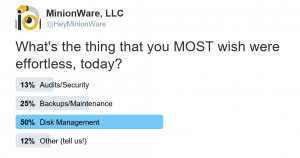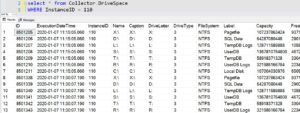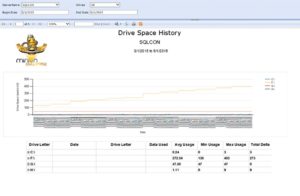 We took an informal poll on Twitter to find out what the biggest pain points are among DBAs. Managing disk space was the overwhelming “winner”.
We took an informal poll on Twitter to find out what the biggest pain points are among DBAs. Managing disk space was the overwhelming “winner”.
This isn’t a giant surprise to us – after all, we’ve been DBAs ourselves for a long time. I for one remember the pain of gathering capacity and growth numbers, then to try predicting our needs for the coming year.
Companies are notoriously conservative with disk space (which is expensive!), especially for databases – which tend to be disk hogs, of course. And that’s the final pain point: proving that the databases really need more space for both data and backups, before you drown in “low disk” alerts!
Minion Enterprise solves these three major pain points for disk space management: data collection, alerting, and projecting.
Data Collection
 A big strength of Minion Enterprise (ME) is its metadata collecting, which includes all kinds of information about SQL Server, Windows, and (of course) disk space and usage.
A big strength of Minion Enterprise (ME) is its metadata collecting, which includes all kinds of information about SQL Server, Windows, and (of course) disk space and usage.
ME customers have been thrilled to have that data in a central repository, with zero effort on their part, and hours and hours of time saved.
Even better, it’s now possible to prove that disk space is being used, and not frittered away on…actually, I’ve never figured out what SAN admins think we use disk space for. In any case, we have the hard numbers.
(“Look there, Sam! Data files are what’s using up that 1.5 Tb!” “Gee, Kelly, I guess you’re right! I’ll get the request in for more space right now!”)
 Alerting
Alerting
Many DBAs are a fan of the daily database checklist – an amorphous entity that changes from one shop to another. Experienced DBAs tend to automate these checklists, as time permits. Minion Enterprise has automated that checklist for them, and that includes configurable, consolidated low disk space alerts.
In my DBA days, I wanted three things when it comes to dangerously low disk space:
First, to hear about it while there’s still plenty of time to do something. – ME alerts are automatic, and have a generous default alert setting.
Second, to STOP hearing about it if I know what the issue is, or if I know the situation won’t change. – ME alerts are simple to defer and re-configure. And it’s easy to enter an exception for those few disks that I don’t want to be alerted on!
Third, to not get a thousand identical alerts. – To fix this common issue, ME does two things: consolidated alerts, meaning that one alert email can contain several alerts (instead of one email per alert!); and, the deferral/exception features mentioned above.
When will the disks fill up?
Minion Enterprise collects and stores data (for a configurable amount of time). So it follows that you can use past data growth rates to predict future disk space needs!
For more, see our webinar on Managing and Projecting Disk Space in ME (starting at 10:45).
Time saved
Space used and space needed are indeed things that we can collect without Minion Enterprise, of course. The problem is, first, that manual data gathering doesn’t give you a usable history of growth over time. And second, that it takes so much time. Let’s take an example.
A DBA who works in a shop with 100 SQL Server instances could get the file sizes and drive capacity (and space used) by hand in about three or four hours.
If she’s very efficient AND knows how to script, she can cut the time quite a bit, but she has to get the script worked out first. Many DBAs don’t have the luxury of free time between crises!
Minion Enterprise, on the other hand, takes five minutes to install, and then it collects the data for you. The report is then available to you at any time via the Minion Enterprise user interface, SSRS report, or stored procedure call!
To summarize:
- Manual data collection = 3-4 hours.
- Minion Enterprise = 1-2 minutes.
Learn more
There are many ways to talk to us and get your hands on a ME trial / demo, so take your pick!
- Use this form
- Email Sales@MinionWare.net
- Message us on Twitter @HeyMinionWare
- Talk to us at an upcoming event
Cheers!


